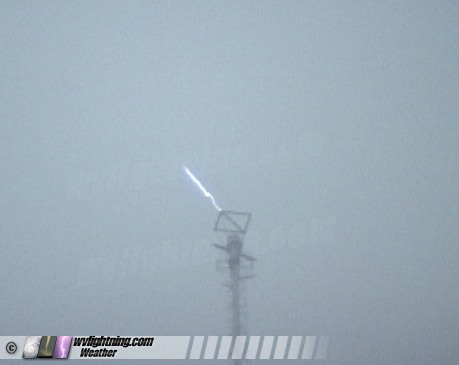
Natural fireworks drown out man's: Storms cancel many Independence Day plans statewide: July 4, 2006
ABOVE: One of many direct hits to the WVAH television tower near St. Albans on Tuesday evening.
HD EXPEDITION VIDEO: Close-up tower lightning: Watch Video
ST. ALBANS, WV - Even though 4th of July was rained out across much of the northeast, a fireworks show of the natural variety was put on by storms that moved across West Virginia on Tuesday. Lightning strikes caused power outages across the Charleston metro, and the WVAH TV tower in St. Albans was hit directly numerous times within minutes - proving that lightning can hit the same place more than once.
Enduring 30 minutes of standing outside in a thunderstorm core paid off this evening. I captured four out of seven strikes to the WVAH tower with all three video cameras, with wide, telephoto and extreme telephoto views. Heavy rain, strong winds and low clouds enveloping the tower prevented capture of the first three strikes.
The lightning channel bead-out is visible along with a shower of glowing molten metal fragments from the antenna tip. Loud thunder follows the strikes.
Frames from video (click thumbnails to enlarge):
From camera #1:











From camera #2:















From camera #3:








Images of Upward-Propagating Lightning Leaders
The most remarkable event tonight was the observation and capture on video of two upward 'leaders' or 'streamers' off of the antenna tip. These particular events were not 'ghost images' or 'false leaders' otherwise common with videotaped strikes (see http://stormhighway.com/videoghost.php). The leaders occured in conjunction and simultaneously with in-cloud lightning flashes above the tower.
Leader Event #1
A lightning leader began propagating upward from the antenna tip, but did not complete a cloud connection to a full discharge - rather ending abruptly in mid-air approximately 200-300 feet above the tower. The video image supports this, as well as the thunder observed and audibly recorded by the cameras. The noise consisted of a short 'sizzling' sound that resembled the start of a normal peal of thunder, but stopping abruptly after a split second due to the fact that the leader channel was only 200-300 feet in length.
Camera #3 was shooting wide and captured the entire leader channel (contrast enhanced):

Camera #2 was zoomed and captured the lower section of the channel:

Note that a 'ghost image' channel would be shifted downward on the screen (see http://stormhighway.com/videoghost.php). This channel is in the correct position on the video image, its lower terminus correlating to the antenna tip. A 'ghost leader' would also have preceded a full discharge, in this case which there was none.
Unfortunately I was changing the tape on camera #1 and did not get the extreme telephoto view of this leader.
The following is the video from cameras #2 and #3. Listen closely for the thunder as described above (a short sizzling sound).
WMV clip, 5.8MB
Leader Event #2
This was a second leader that occured in conjunction with an in-cloud flash above the tower. As with the previously posted example, this one also did not connect to full discharge. It is considerably shorter than the previous example - approximately 10 to 15 feet in length based on the estimated size of the tower tip. Cameras #1 and #2 both caught this leader:
From camera #1 (extreme telephoto):

From camera #2 (telephoto):

The video frames before and after this leader show no visible lightning or leader channel. Unlike the 200-300 foot example posted yesterday, there was no audible sound associated with this smaller leader. Again, this image is not a video 'ghost channel' anomaly - note that the leader is in the correct position, is connected to the tower tip, is identical in both camera views, and is not followed by a full lightning discharge in subsequent frames.
Leader Event #3
Another item of interest is the capture by cameras #1 and #2 of the very first stages of upward leader initiation on a frame preceding a full discharge. The leader channel on this frame is no more than 5 to 10 feet long:
From camera #1 (extreme telephoto):

From camera #2 ( telephoto):

Unlike leader events #1 and #2, this leader did go on to complete a full discharge connection as pictured here:

All upward lightning events begin with the initiation of a luminous leader channel that propagates skyward prior to the bright, intense return stroke. While all upward lightning discharges contain leaders, video cameras do not always capture them as they did with the above example.
GO: Home | Storm Chase Logs | Photography | Extreme Weather Library | Stock Footage | Blog
Featured Weather Library Article:
|